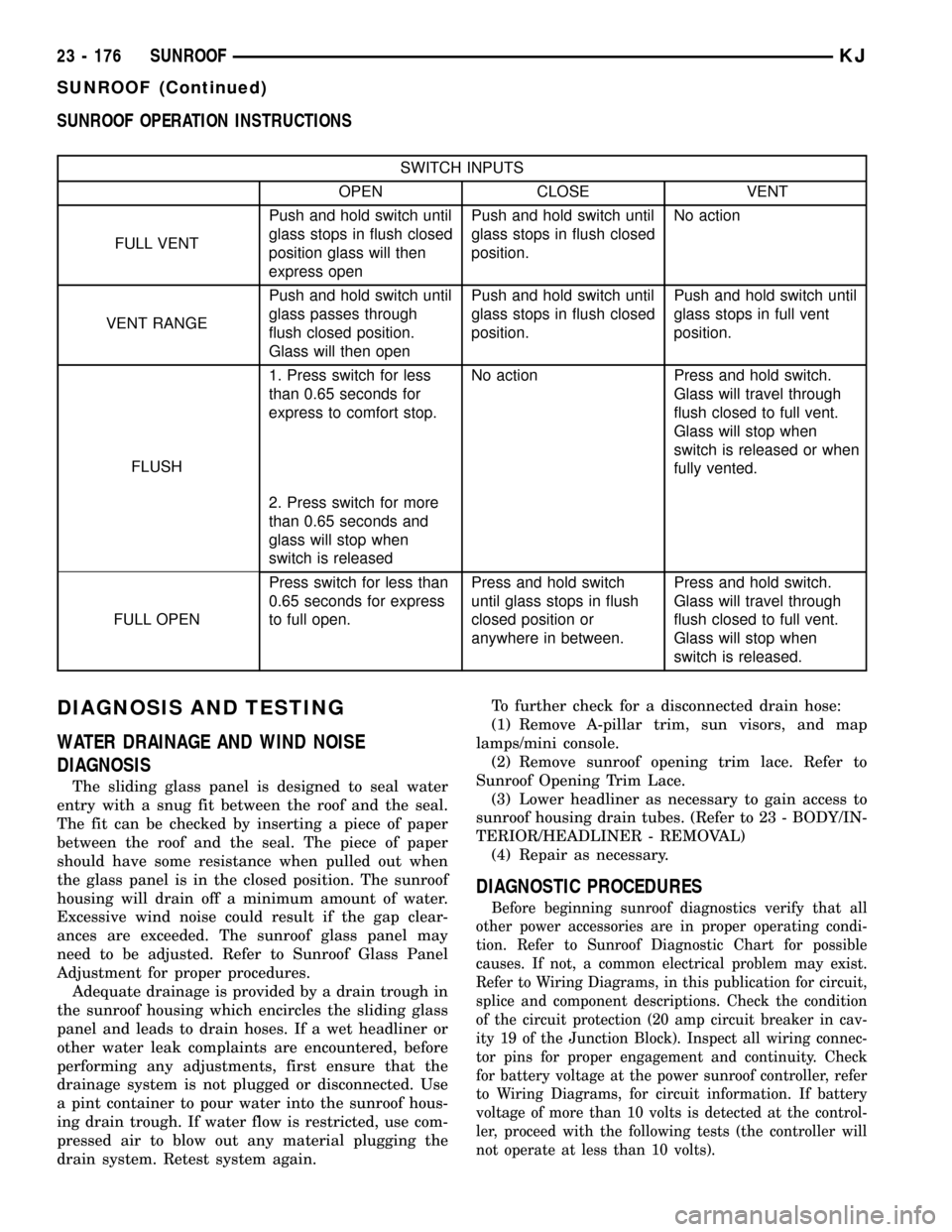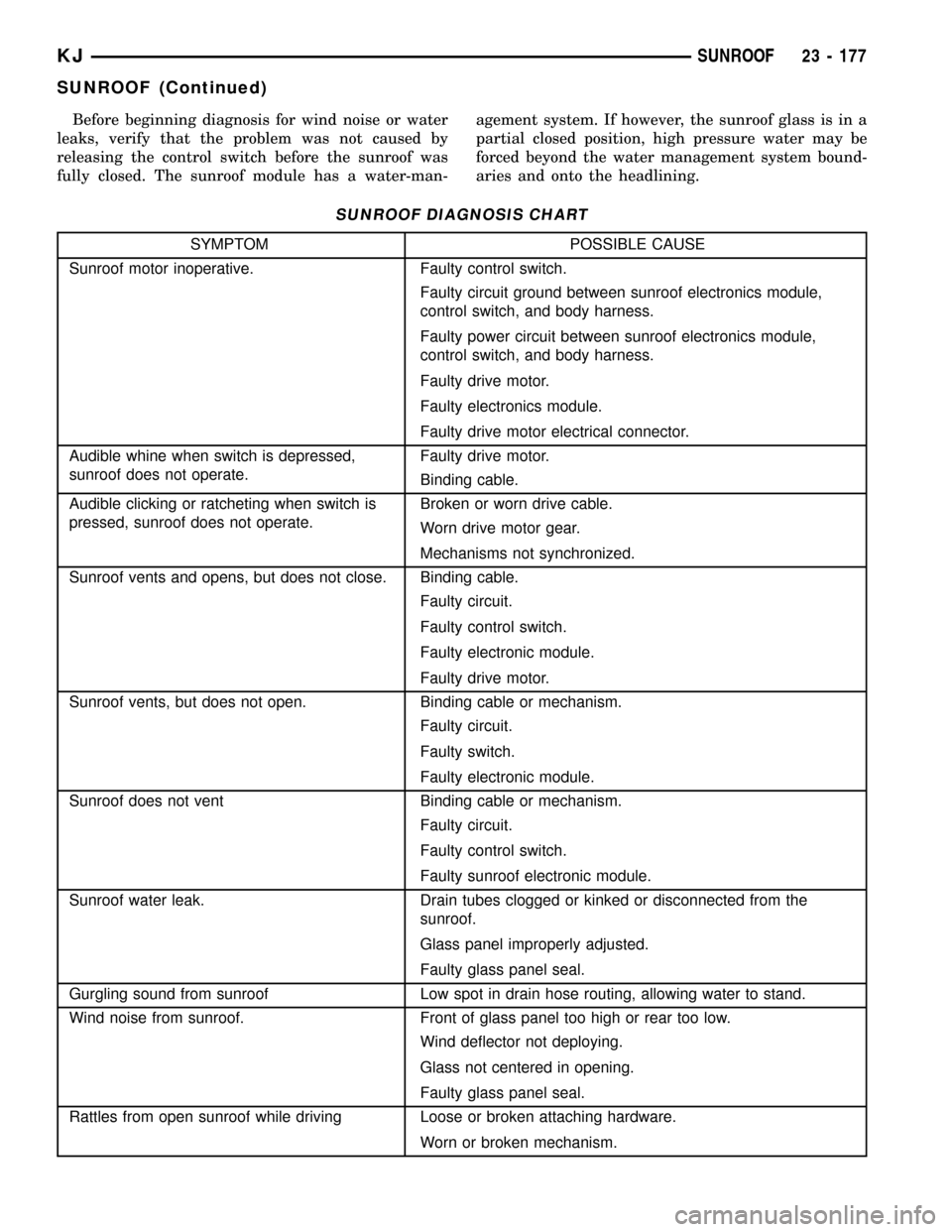2002 JEEP LIBERTY Body sunroof
[x] Cancel search: Body sunroofPage 1624 of 1803

HEADLINER
REMOVAL
(1) Remove the a-pillar trim. (Refer to 23 - BODY/
INTERIOR/A-PILLAR TRIM AND GRAB HANDLE -
REMOVAL)
(2) Remove the visors. (Refer to 23 - BODY/INTE-
RIOR/SUN VISOR - REMOVAL)
(3) Remove the sun visor support. (Refer to 23 -
BODY/INTERIOR/SUN VISOR SUPPORT -
REMOVAL)
(4) Remove the overhead console. (Refer to 8 -
ELECTRICAL/OVERHEAD CONSOLE - REMOVAL)
(5) Cut rear washer hose at the mark about half-
way up the a-pillar.
(6) Remove the upper b-pillar trim. (Refer to 23 -
BODY/INTERIOR/B-PILLAR UPPER TRIM -
REMOVAL)
(7) Remove the assist handles. (Refer to 23 -
BODY/INTERIOR/ASSIST HANDLE - REMOVAL)
(8) Remove the quarter trim. (Refer to 23 - BODY/
INTERIOR/QUARTER TRIM PANEL - REMOVAL)
(9) Disconnect the electrical connector along the
left d-pillar and remove the ground wire.
(10) Remove the dome light in the rear.
(11) Remove the sunroof opening trim lace, if
equipped. (Refer to 23 - BODY/SUNROOF/OPENING
TRIM LACE - REMOVAL)(12) Remove the rear washer nozzle.
(13) Remove the headliner.
INSTALLATION
(1) Install the headliner.
(2) Install the assist handles. (Refer to 23 - BODY/
INTERIOR/ASSIST HANDLE - INSTALLATION)
(3) Install the visors. (Refer to 23 - BODY/INTERI-
OR/SUN VISOR - INSTALLATION)
(4) Install the visor supports. (Refer to 23 - BODY/
INTERIOR/SUN VISOR SUPPORT - INSTALLA-
TION)
(5) Install the overhead console. (Refer to 8 -
ELECTRICAL/OVERHEAD CONSOLE - INSTALLA-
TION)
(6) Connect the rear washer hose, previously cut,
with a hose junction.
(7) Install the a-pillar trim and grab handles.
(Refer to 23 - BODY/INTERIOR/A-PILLAR TRIM -
INSTALLATION)
(8) Install the upper b-pillar trim. (Refer to 23 -
BODY/INTERIOR/B-PILLAR UPPER TRIM -
INSTALLATION)
(9) Install the rear washer nozzle.
(10) Connect the electrical connector and ground
wire at the left d-pillar.
(11) Install the quarter trim panels. (Refer to 23 -
BODY/INTERIOR/QUARTER TRIM PANEL -
INSTALLATION)
(12) Install the rear dome light.
(13) Install the sunroof opening trim lace, if
equipped. (Refer to 23 - BODY/SUNROOF/OPENING
TRIM LACE - INSTALLATION)
QUARTER TRIM PANEL
REMOVAL
(1) Using a trim stick C-4755 or equivalent,
remove the rear header trim.
(2) Using a trim stick C-4755 or equivalent,
remove the rear sill plate.
(3) Remove the hook pin type connector.
(4) Fold down the rear seat.
(5) Remove the seat belt anchor and pivot. (Refer
to 8 - ELECTRICAL/RESTRAINTS/SEAT BELT &
RETRACTOR - REMOVAL)
(6) Remove the belt access panel. (Fig. 4)
(7) Remove the storage cover.
(8) Disconnect the 12v power supply electrical con-
nector, if equipped.
INSTALLATION
(1) Position the 12v power supply electrical con-
nector, if equipped.
(2) Install the storage cover.
Fig. 3 FLOOR CONSOLE
1 - SHIFT BEZEL
2 - ACCESSORY CUP
3 - BOLTS (4)
4 - FLOOR CONSOLE
KJINTERIOR 23 - 159
FLOOR CONSOLE LID LATCH (Continued)
Page 1640 of 1803

SUNROOF
TABLE OF CONTENTS
page page
SUNROOF
DESCRIPTION........................175
DIAGNOSIS AND TESTING
WATER DRAINAGE AND WIND NOISE
DIAGNOSIS.........................176
DIAGNOSTIC PROCEDURES...........176
GLASS PANEL
REMOVAL............................178
INSTALLATION........................178
ADJUSTMENTS
SUNROOF GLASS PANEL ADJUSTMENT . . 178
GLASS PANEL SEAL
REMOVAL............................178
INSTALLATION........................178
SUNSHADE
REMOVAL............................179
INSTALLATION........................179
GUIDE ASSEMBLY
REMOVAL............................179
INSTALLATION........................179
WIND DEFLECTOR
REMOVAL............................180INSTALLATION........................180
OPENING TRIM LACE
REMOVAL............................180
INSTALLATION........................180
DRAIN TUBE
REMOVAL............................180
INSTALLATION........................181
MODULE ASSEMBLY
REMOVAL............................181
INSTALLATION........................181
DRIVE MOTOR
REMOVAL............................182
INSTALLATION........................182
CONTROL MODULE
REMOVAL............................183
INSTALLATION........................183
CONTROL SWITCH
DESCRIPTION........................184
OPERATION..........................184
DIAGNOSIS AND TESTING...............184
REMOVAL............................184
INSTALLATION........................184
SUNROOF
DESCRIPTION
WARNING: Keep fingers and other body parts out
of sunroof opening at all times.
The sunroof features a power sliding glass panel
and a sunshade which can be manually positioned
anywhere along its travel, rearward of glass panel
front edge.
The sunroof is electrically operated from two
switches located on the windshield header, rearwardof the map lamp. To operate the sunroof the ignition
switch must be in either the Accessory or On/Run
position. One switch (vent) is a push button type and
opens the sunroof to the vent position only. The other
switch (open/close) is a rocker type for opening and
closing the sunroof. Pressing and releasing the open
button once the sunroof will express open and the
wind deflector will raise. If the button is pressed a
second time the sunroof will stop in that position.
Pressing and holding the close button will close the
sunroof. If the close button is released the sunroof
will stop in that position.
KJSUNROOF 23 - 175
Page 1641 of 1803

SUNROOF OPERATION INSTRUCTIONS
SWITCH INPUTS
OPEN CLOSE VENT
FULL VENTPush and hold switch until
glass stops in flush closed
position glass will then
express openPush and hold switch until
glass stops in flush closed
position.No action
VENT RANGEPush and hold switch until
glass passes through
flush closed position.
Glass will then openPush and hold switch until
glass stops in flush closed
position.Push and hold switch until
glass stops in full vent
position.
FLUSH1. Press switch for less
than 0.65 seconds for
express to comfort stop.No action Press and hold switch.
Glass will travel through
flush closed to full vent.
Glass will stop when
switch is released or when
fully vented.
2. Press switch for more
than 0.65 seconds and
glass will stop when
switch is released
FULL OPENPress switch for less than
0.65 seconds for express
to full open.Press and hold switch
until glass stops in flush
closed position or
anywhere in between.Press and hold switch.
Glass will travel through
flush closed to full vent.
Glass will stop when
switch is released.
DIAGNOSIS AND TESTING
WATER DRAINAGE AND WIND NOISE
DIAGNOSIS
The sliding glass panel is designed to seal water
entry with a snug fit between the roof and the seal.
The fit can be checked by inserting a piece of paper
between the roof and the seal. The piece of paper
should have some resistance when pulled out when
the glass panel is in the closed position. The sunroof
housing will drain off a minimum amount of water.
Excessive wind noise could result if the gap clear-
ances are exceeded. The sunroof glass panel may
need to be adjusted. Refer to Sunroof Glass Panel
Adjustment for proper procedures.
Adequate drainage is provided by a drain trough in
the sunroof housing which encircles the sliding glass
panel and leads to drain hoses. If a wet headliner or
other water leak complaints are encountered, before
performing any adjustments, first ensure that the
drainage system is not plugged or disconnected. Use
a pint container to pour water into the sunroof hous-
ing drain trough. If water flow is restricted, use com-
pressed air to blow out any material plugging the
drain system. Retest system again.To further check for a disconnected drain hose:
(1) Remove A-pillar trim, sun visors, and map
lamps/mini console.
(2) Remove sunroof opening trim lace. Refer to
Sunroof Opening Trim Lace.
(3) Lower headliner as necessary to gain access to
sunroof housing drain tubes. (Refer to 23 - BODY/IN-
TERIOR/HEADLINER - REMOVAL)
(4) Repair as necessary.
DIAGNOSTIC PROCEDURES
Before beginning sunroof diagnostics verify that all
other power accessories are in proper operating condi-
tion. Refer to Sunroof Diagnostic Chart for possible
causes. If not, a common electrical problem may exist.
Refer to Wiring Diagrams, in this publication for circuit,
splice and component descriptions. Check the condition
of the circuit protection (20 amp circuit breaker in cav-
ity 19 of the Junction Block). Inspect all wiring connec-
tor pins for proper engagement and continuity. Check
for battery voltage at the power sunroof controller, refer
to Wiring Diagrams, for circuit information. If battery
voltage of more than 10 volts is detected at the control-
ler, proceed with the following tests (the controller will
not operate at less than 10 volts).
23 - 176 SUNROOFKJ
SUNROOF (Continued)
Page 1642 of 1803

Before beginning diagnosis for wind noise or water
leaks, verify that the problem was not caused by
releasing the control switch before the sunroof was
fully closed. The sunroof module has a water-man-agement system. If however, the sunroof glass is in a
partial closed position, high pressure water may be
forced beyond the water management system bound-
aries and onto the headlining.
SUNROOF DIAGNOSIS CHART
SYMPTOM POSSIBLE CAUSE
Sunroof motor inoperative. Faulty control switch.
Faulty circuit ground between sunroof electronics module,
control switch, and body harness.
Faulty power circuit between sunroof electronics module,
control switch, and body harness.
Faulty drive motor.
Faulty electronics module.
Faulty drive motor electrical connector.
Audible whine when switch is depressed,
sunroof does not operate.Faulty drive motor.
Binding cable.
Audible clicking or ratcheting when switch is
pressed, sunroof does not operate.Broken or worn drive cable.
Worn drive motor gear.
Mechanisms not synchronized.
Sunroof vents and opens, but does not close. Binding cable.
Faulty circuit.
Faulty control switch.
Faulty electronic module.
Faulty drive motor.
Sunroof vents, but does not open. Binding cable or mechanism.
Faulty circuit.
Faulty switch.
Faulty electronic module.
Sunroof does not vent Binding cable or mechanism.
Faulty circuit.
Faulty control switch.
Faulty sunroof electronic module.
Sunroof water leak. Drain tubes clogged or kinked or disconnected from the
sunroof.
Glass panel improperly adjusted.
Faulty glass panel seal.
Gurgling sound from sunroof Low spot in drain hose routing, allowing water to stand.
Wind noise from sunroof. Front of glass panel too high or rear too low.
Wind deflector not deploying.
Glass not centered in opening.
Faulty glass panel seal.
Rattles from open sunroof while driving Loose or broken attaching hardware.
Worn or broken mechanism.
KJSUNROOF 23 - 177
SUNROOF (Continued)
Page 1643 of 1803

GLASS PANEL
REMOVAL
(1) Slide sunshade rearward to the open position.
(2) Move the glass panel to the closed position.
(3) Remove the four glass panel screws (Fig. 1).
(4) Lift off glass panel and remove from vehicle.
INSTALLATION
(1) Position glass panel on to mechanism lift arm.
(2) Start the four attaching screws.
(3) Center glass in opening by running a business
card around the glass.
(4) Adjust glass panel. (Refer to 23 - BODY/SUN-
ROOF/GLASS PANEL - ADJUSTMENTS)
ADJUSTMENTS
SUNROOF GLASS PANEL ADJUSTMENT
(1) Move the sunshade rearward to the open posi-
tion.
(2) Move the sunroof glass panel to the fully closed
position.
(3) Adjust the glass one corner at a time.
(a) Loosen four glass screws (Fig. 2).
(b) Lift glass assembly and align the top of the
glass panel to the top of the roof panel.
(c) Tighten screw to 3.5 N´m (31 in. lbs.).
(d) Repeat steps a. and b. for each corner of the
glass panel.
(e) When properly adjusted, the front of the
glass panel is 1.75 mm (0.07 in.) to 2.75 mm (0.11
in.) lower than the roof surface and the rear edgeof the glass panel is 1.75mm (0.07 in.) to .75 mm
(0.03 in.) lower than the roof surface.
NOTE: Glass assembly seal is 2.5mm (0.1 in) higher
than the glass panel. Measure at 300mm (11.8 in)
outboard of the centerline of the vehicle.
(4) Verify sunroof operation and alignment. Check
fit and re-adjust as necessary.
GLASS PANEL SEAL
REMOVAL
(1) Remove sunroof glass panel. (Refer to 23 -
BODY/SUNROOF/GLASS PANEL - REMOVAL)
(2) Place glass panel on clean work area with the
top side up. Support the glass assembly from under-
side to avoid bending or otherwise damaging the
mounting tabs.
(3) Grasp the seal and pull seal away from the
glass panel. The seal is a one piece seal.
INSTALLATION
NOTE: Always position seal seam on center of the
passenger side of glass panel.
(1) Place seal into position.
(2) Install seal on glass. Using care working the
seal around the glass, being careful not to over
stretch the seal while installing.
(3) Install the glass panel. (Refer to 23 - BODY/
SUNROOF/GLASS PANEL - INSTALLATION)
Fig. 1 GLASS PANEL
1 - SCREWS
2 - GLASS PANEL
3 - MODULE ASSEMBLYFig. 2 GLASS PANEL
1 - SCREWS
2 - GLASS PANEL
3 - MODULE ASSEMBLY
23 - 178 SUNROOFKJ
Page 1644 of 1803

SUNSHADE
REMOVAL
(1) Remove glass assembly from the sunroof
assembly. (Refer to 23 - BODY/SUNROOF/GLASS
PANEL - REMOVAL)
(2) Remove two screws from trough assembly (Fig.
3).
(3) Remove trough assembly.
(4) Slide the sunshade forward to disengage the
guide feet from the tracks through the cutouts at the
front of the tracks.
CAUTION: Use care not to crease the sunshade
when removing or installing.
INSTALLATION
(1) Place sunshade into position, through the cut-
outs at the front of the tracks and slide the sunshade
back.
(2) Place trough assembly into position on sunroof
module and install the screws.
(3) Install the glass panel. (Refer to 23 - BODY/
SUNROOF/GLASS PANEL - INSTALLATION)
GUIDE ASSEMBLY
REMOVAL
(1) Remove the glass panel. (Refer to 23 - BODY/
SUNROOF/GLASS PANEL - REMOVAL)
(2) Place sunroof into the vent position.
(3) Remove two screws from trough assembly (Fig.
3).
(4) Remove trough assembly.
(5) Disconnect the guide link (Fig. 4).
(6) Slide trough guide forward and disengage the
sliders through the notches in the guide channels
(Fig. 5).
INSTALLATION
(1) Install the trough guide and engage the sliders
into the guide channels through the notches.
(2) Connect the guide link.
(3) Install the trough and install the two screws.
(4) Install the glass panel. (Refer to 23 - BODY/
SUNROOF/GLASS PANEL - INSTALLATION)
Fig. 3 GUIDE ASSEMBLY TROUGH
1 - TROUGH
2 - TROUGH GUIDE
3 - SCREW
Fig. 4 TROUGH GUIDES
1 - TROUGH GUIDE
2 - GUIDE LINK
KJSUNROOF 23 - 179
Page 1645 of 1803

WIND DEFLECTOR
REMOVAL
(1) Open sunroof glass panel to the full open posi-
tion.
(2) Remove screws attaching wind deflector straps
to front crossmember (Fig. 6).(3) Rotate wind deflector back about 110É and slide
backwards to disengage from the spring hook.
INSTALLATION
(1) Place wind deflector in position 110É to roof.
(2) Push arms down and forward to engage spring
hooks.
(3) Rotate wind deflector forward into correct posi-
tion. Depress wind deflector down onto front cross-
member to check spring function.
(4) Install fasteners attaching wind deflector
straps to front crossmember.
(5) Test sunroof operation.
OPENING TRIM LACE
REMOVAL
(1) Remove lace by starting at the joint center of
the opening on driver's side.
(2) Pull one end of the lace away from the head-
liner until the entire lace is removed.
INSTALLATION
(1) Place end of trim lace into position starting at
center of the opening on driver's side.
(2) Push lace into position.
(3) Ensure that the corner radii is fully engage.
(4) Once trim lace is attached to sunroof module
begin tucking the headline under the lip on the trim
lace working all the way around the opening.
DRAIN TUBE
REMOVAL
FRONT DRAIN TUBES
(1) Move glass panel to the fully closed position.
(2) Remove sunroof opening trim lace.
(3) Remove the headliner. (Refer to 23 - BODY/IN-
TERIOR/HEADLINER - REMOVAL)
(4) Disconnect the drain hose from the sunroof
housing (Fig. 7).
(5) Drain any liquid from hose connection, if nec-
essary.
(6) Remove the instrument panel top panel. (Refer
to 23 - BODY/INSTRUMENT PANEL/INSTRUMENT
PANEL TOP COVER - REMOVAL)
(7) Disconnect the grommet, attachment clips and
remove the drain tube.
REAR DRAIN TUBES
(1) Move glass panel to the fully closed position.
(2) Remove sunroof opening trim lace.
(3) Remove headliner.
Fig. 5 TROUGH GUIDE REMOVAL
1 - TROUGH GUIDE
2 - NOTCH
3 - SLIDER
Fig. 6 SUNSHADE
1 - WIND DEFLECTOR
2 - SCREW
3 - SPRING
23 - 180 SUNROOFKJ
GUIDE ASSEMBLY (Continued)
Page 1646 of 1803

(4) Disconnect the drain hose from the sunroof
housing (Fig. 8).
(5) Drain any liquid from hose connection, if nec-
essary.
(6) Disconnect the grommet, attachment clips and
remove the drain tube.
INSTALLATION
FRONT DRAIN TUBES
(1) Connect the drain hose to the sunroof housing
and test drainage.
(2) Connect the body grommet and attachment
clips.
(3) Install the instrument panel top panel. (Refer
to 23 - BODY/INSTRUMENT PANEL/INSTRUMENT
PANEL TOP COVER - INSTALLATION)
(4) Install the headliner. (Refer to 23 - BODY/IN-
TERIOR/HEADLINER - INSTALLATION)
(5) Install sunroof opening trim lace. (Refer to 23 -
BODY/SUNROOF/OPENING TRIM LACE - INSTAL-
LATION)
REAR DRAIN TUBES
(1) Connect the drain hose to the sunroof housing
and test drainage.
(2) Connect the body grommet and attachment
clips.
(3) Install the headliner.(4) Install sunroof opening trim lace.
MODULE ASSEMBLY
REMOVAL
(1) Move glass panel to the fully closed position.
(2) Disconnect and isolate the negative battery
cable.
(3) Remove sunroof opening trim lace.
(4) Remove headliner. (Refer to 23 - BODY/INTE-
RIOR/HEADLINER - REMOVAL)
(5) Disconnect wire harness push in fasteners and
electrical connector. (Fig. 9)
(6) Disconnect the drain tubes from sunroof hous-
ing.
(7) Loosen fasteners attaching sunroof module
assembly.
(8) With the aid of a helper, remove fasteners
attaching sunroof module assembly to roof panel
(Fig. 10).
INSTALLATION
(1) With the Glass panel in the fully closed posi-
tion.
(2) Raise rear end of sunroof module assembly and
guide into position and start fasteners.
(3) Tighten the fasteners to 9 N´m (80 in. lbs.).
(4) Connect the drain tubes.
Fig. 7 FRONT DRAIN TUBE
1 - TUBE
2 - CLIPS
3 - GROMMET
Fig. 8 REAR DRAIN TUBE
1 - GROMMET
2 - TUBE
3 - CLIPS
KJSUNROOF 23 - 181
DRAIN TUBE (Continued)